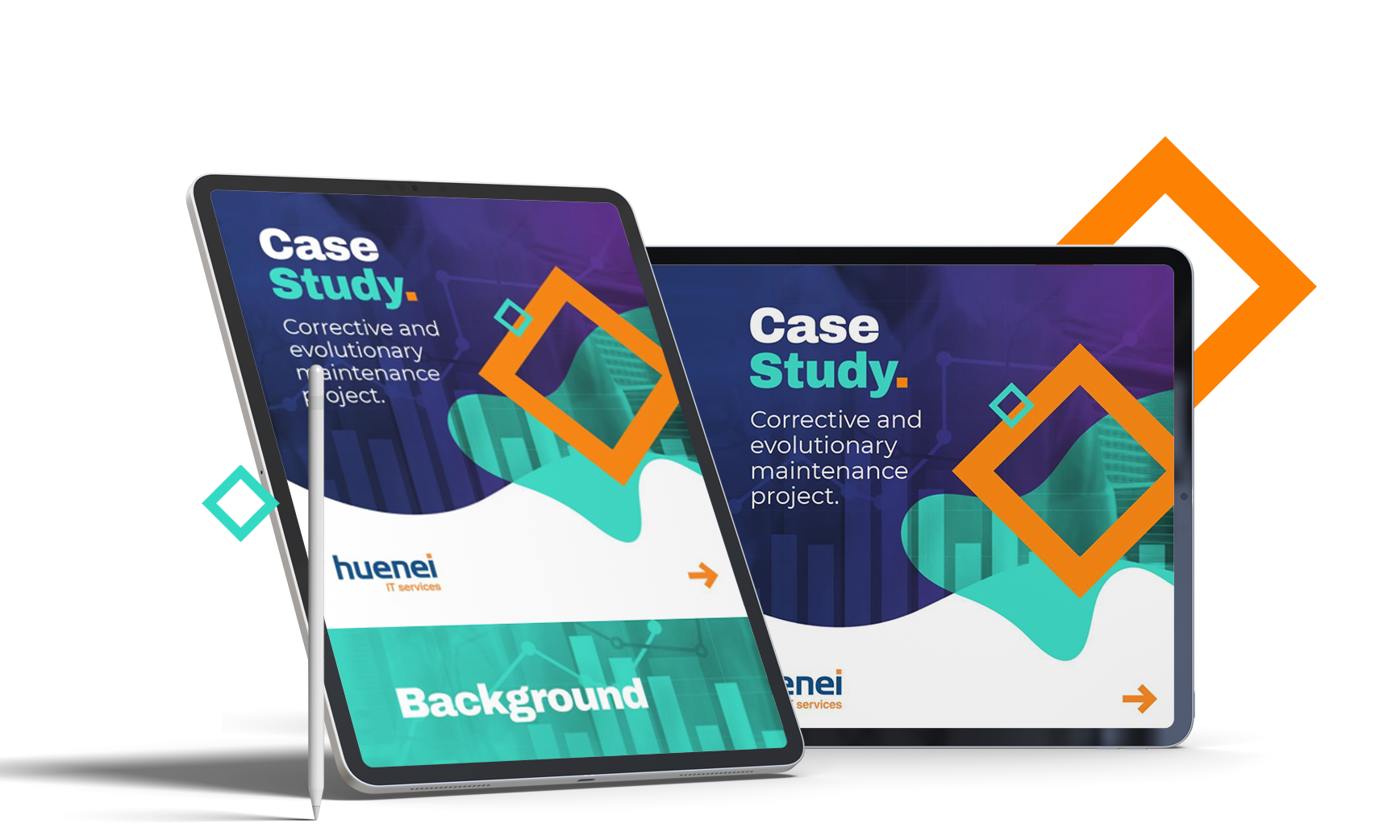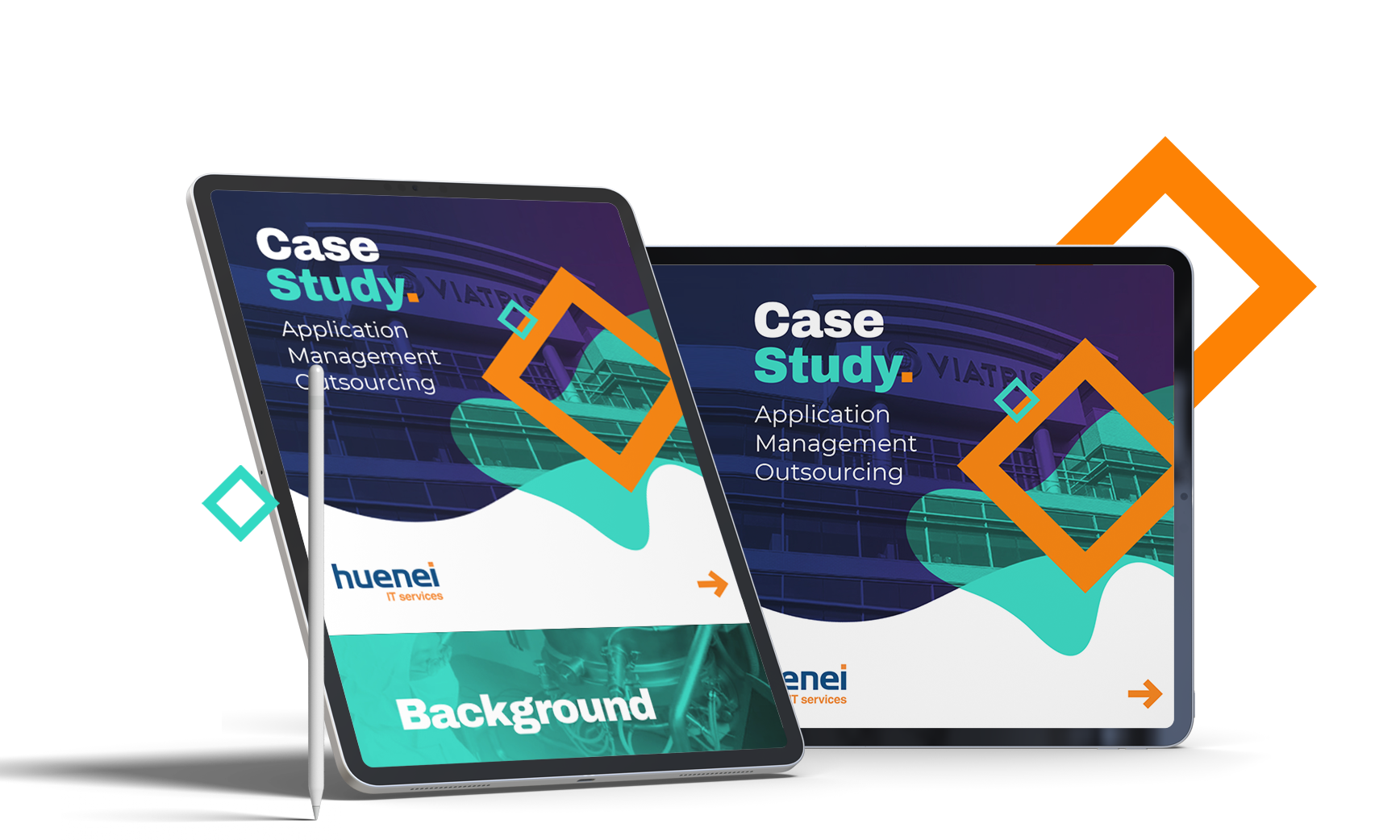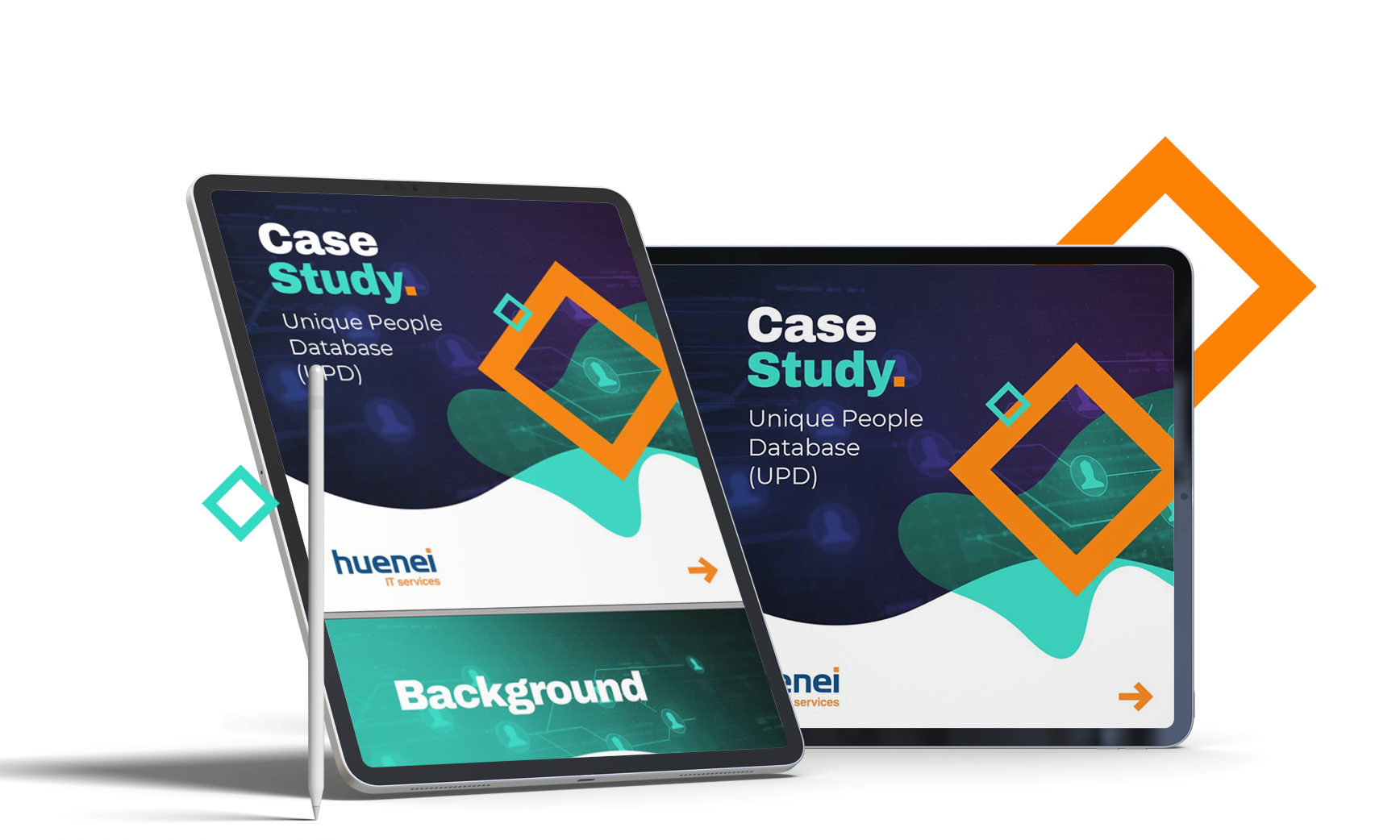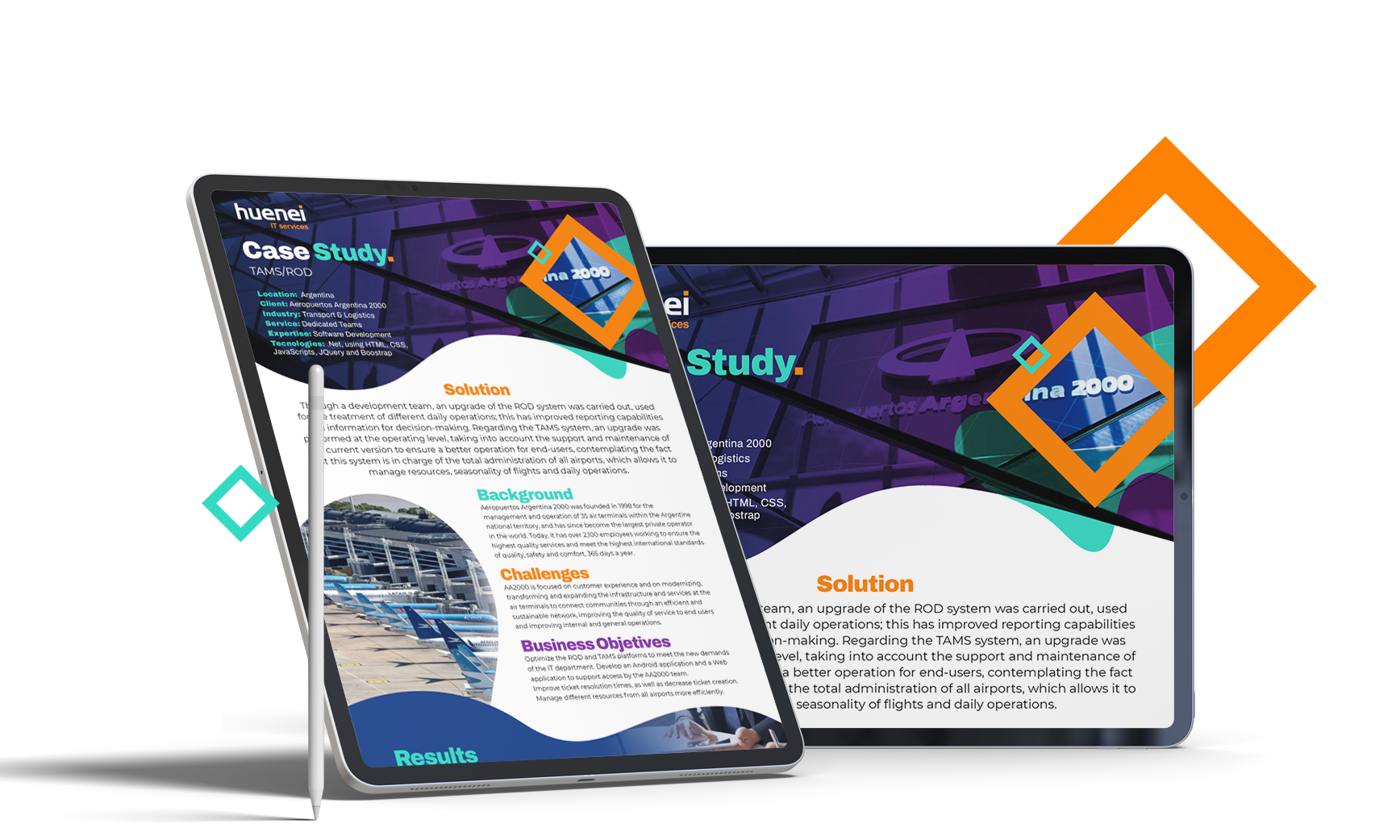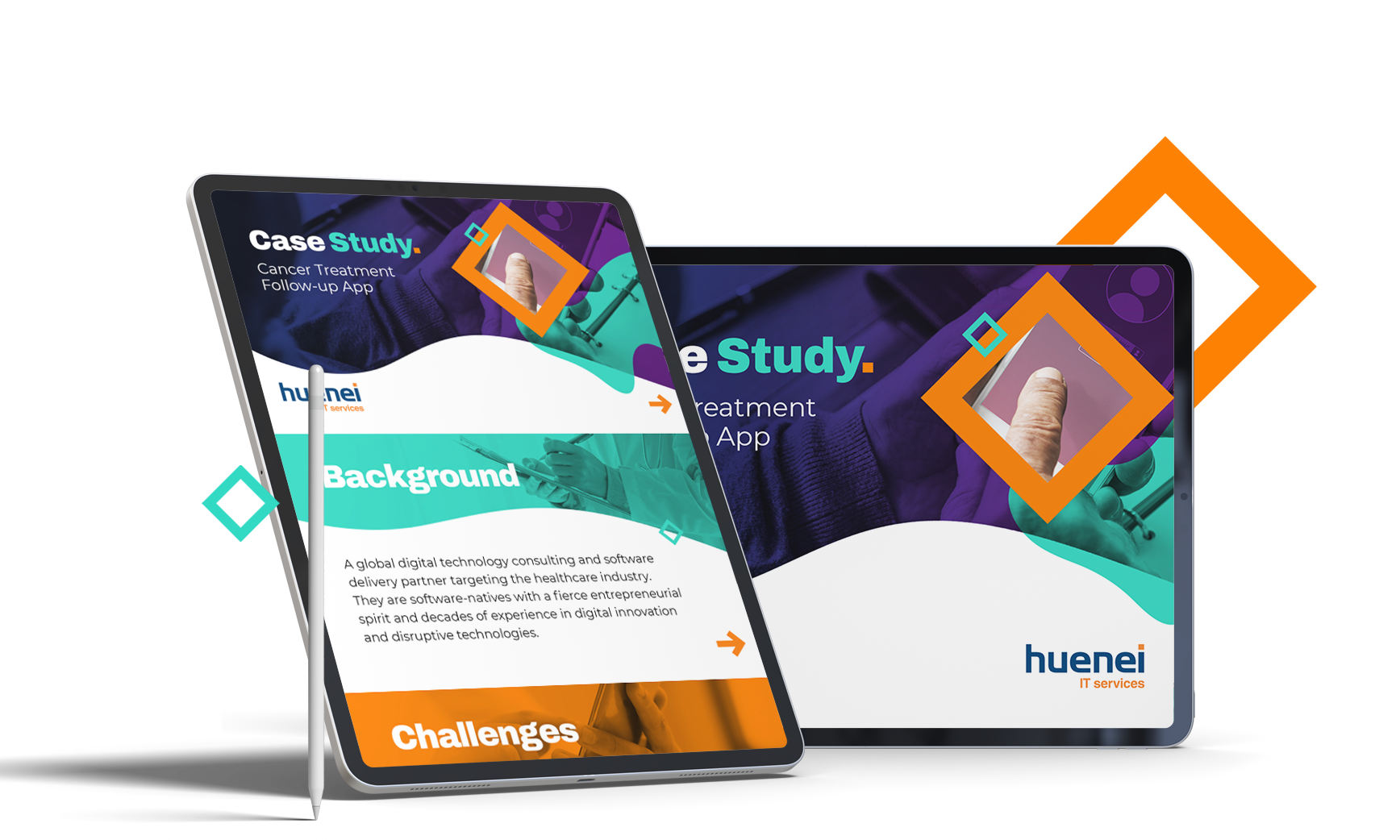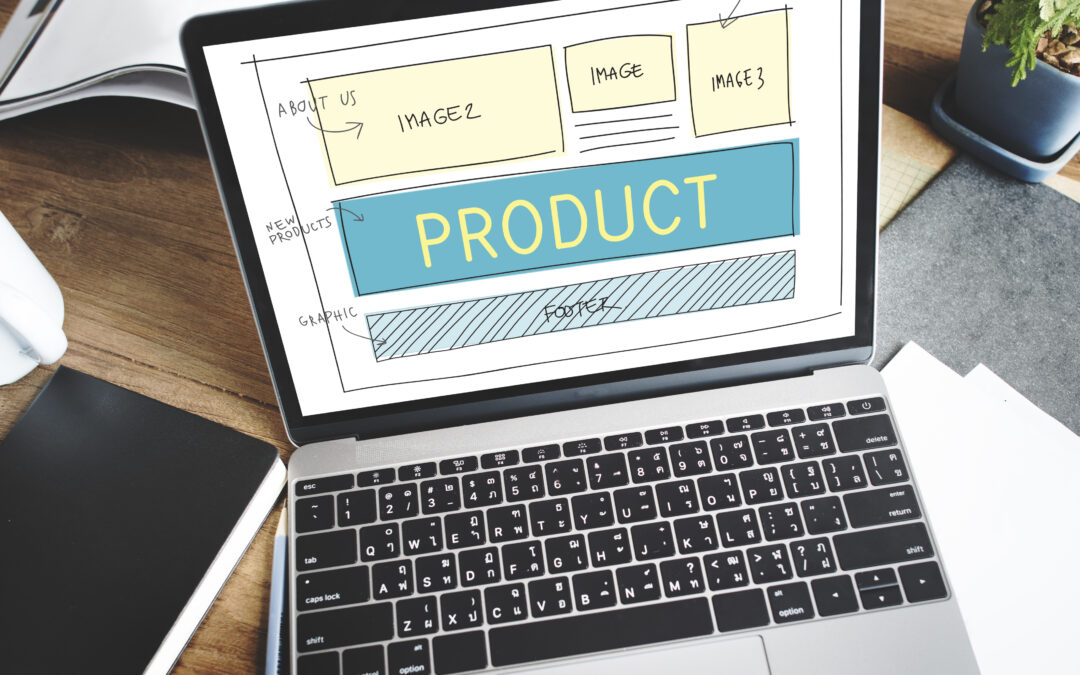
by Huenei IT Services | May 6, 2023 | Process & Management
Digital product development management is a complex process that involves several steps, from idea generation to product launch and post-launch evaluation. To ensure success, it is important to understand the key aspects of digital product development management and best practices for effective management.
In this article, we will explore the steps involved in digital product development management and provide a checklist for successful management. But first, let’s discuss what digital product development management is and why it is important.
Understanding Digital Product Development Management
Digital product development management is creating and managing digital products, such as software, applications, and websites. Effective digital product development management ensures that products are designed and developed with the end user in mind, and are delivered on time and within budget.
This activity has several benefits, including improved product quality, faster time-to-market, and increased customer satisfaction. However, managing product development can also be challenging due to the constantly evolving digital landscape and the need to stay ahead of the competition.
Critical Steps in Digital Product Development Management
Product development management involves a series of key steps that are critical to the success of any digital product. By following these steps and incorporating best practices, businesses can increase their chances of creating successful digital products that meet the needs of their target audience. Let’s outline the five key steps in product development management and provide tips and best practices for each step.
- Idea generation and concept development: This is the first step in the development of digital products. During this phase, ideas are generated, and concepts are developed. It is important to involve all stakeholders, including developers, designers, marketers, and business analysts.
- Market research and competitive analysis: In this step, market research is conducted to understand the needs and preferences of the target audience. Competitive analysis is also conducted to identify potential competitors and understand their strengths and weaknesses.
- Product design and prototyping: During this phase, the product design is created, and prototypes are developed. User feedback is collected to refine the design and ensure that it meets the needs of the target audience.
- Development and testing: This is the phase where the product is developed and tested. It is important to ensure that the product is developed according to the design and that it meets the needs of the target audience.
- Launch and post-launch: In this step, the product is launched, and a post-launch evaluation is conducted to determine whether the product is meeting the needs of the target audience. User feedback is collected and analyzed to identify areas for improvement.

Best Practices for Digital Product Development Management
To ensure successful product development management, it is important to follow best practices. Some of these best practices include:
- Team collaboration and communication: Effective collaboration and communication among team members are essential for successful product development. Regular team meetings and clear communication channels should be established.
- Effective project management: Effective project management is critical for succeeding in the development of digital products. Project milestones should be established, and progress should be regularly monitored.
- Utilizing Agile methodologies: Agile methodologies are becoming increasingly popular in digital product development management. Agile methodologies involve iterative development, which allows for flexibility and the ability to quickly respond to changes.
- Incorporating user feedback throughout the development process: User feedback should be collected and analyzed throughout the development process to ensure that the product meets the needs of the target audience.
Checklist for Successful Digital Product Development Management
To ensure successful product development management, at Huenei we use a checklist that summarizes all the important aspects of the process. We share it with you below so that you can take advantage of our experience and our work methodology in your projects:
- Establish clear goals and objectives for the product.
- Conduct market research and competitive analysis.
- Involve all stakeholders in idea generation and concept development.
- Create a detailed product design and develop prototypes.
- Develop the product and test it.
- Launch the product and collect user feedback.
- Analyze user feedback and make necessary improvements.
- Regularly monitor progress and adjust the development plan as necessary.
- Utilize Agile methodologies for flexibility.
- Communicate regularly with team members and stakeholders.
All in all, digital product development management is a critical process that requires careful planning and execution. By following best practices and utilizing our proposed checklist, businesses can ensure that their products are developed and launched successfully. By involving all stakeholders in the process, conducting market research, and incorporating user feedback throughout the development process, businesses can create products that meet the needs and preferences of their target audience.
Effective communication and collaboration among team members, as well as utilizing Agile methodologies, can also contribute to the successful development of digital products. By regularly monitoring progress and making necessary adjustments, businesses can ensure that their digital products are delivered on time and within budget.

by Huenei IT Services | May 6, 2023 | Process & Management
The Lean Project Charter is a document where we detail the main aspects and considerations of a project, based on its life cycle. This project management tool is a one-pager elaborated to formally authorize a project or a particular phase framed within one.
From an operational perspective, this document is a tool that gathers the work guidelines and functions as a framework that also delimits the software project or of any other nature. It documents the initial requirements that meet the needs and expectations of stakeholders. In this sense, it is useful to keep track of the project at all times and to be well organized during planning, implementation, and control.
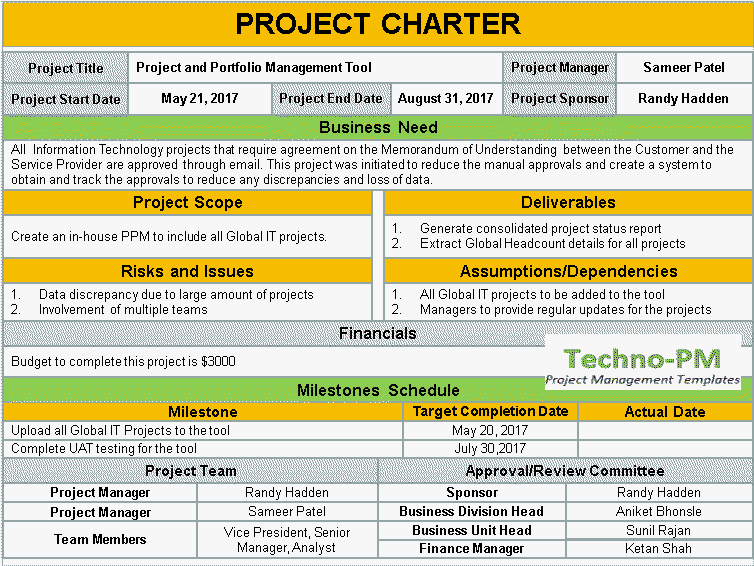
Example by Techno-PM
Why carry out a Lean Project Charter?
Everything that is specified in this document we are going to plan and then we are going to execute. The purpose of this “cover letter” is to standardize and correctly plan the steps involved in the development of a project, in order to be able to carry it out safely from start to finish.
This project management tool links the decision-making managerial level with the project management level. Every project must have a project team led by the project manager. In this charter, it should be very specifically detailed what is the level of authority that this director has to make decisions within the project, whether they are decisions that affect it positively or negatively.
This document is prepared before the development of the project and all strategic stakeholders of the project must participate in its creation to align expectations, agree courses of action and establish preferences regarding the framework and reference of the project.
What is the structure of a Lean Project Charter?
There are various work templates and methodologies to organize a Project Charter, however, the Project Management Institute (PMI) has not defined a specific framework for its implementation. This realizes that each project and each organization shall adapt this project management tool to their particular needs. As general content, it can include the following sections that represent points that must be adapted to each project in particular:
- Project data. Here you should specify the enterprise, the project’s name, the date of preparation of the Project Charter, the clients, and the project manager.
- Purpose and justification, which allows demonstrating the reasons why the product or service in question needs to be developed. You should specify the context of the organization, the needs to satisfy, and all the legal requirements.
- Deliverables. This section is about the minimum viable products, documents, partial processes, and others, that are elaborated to complete and measure a project. It is important to clarify that the deliverables must be measurable and verifiable.
- Project life cycle. This phase represents the set of phases into which the project is divided. Many times we structure is based on some work methodology such as Design Thinking.
- Objectives of the project, which represent the goals that we set ourselves with the purpose of understanding, in the charter project, why we are carrying out this project.
- Budget, understood as the preliminary estimate of the resources needed to complete the project activities.
- Schedule of main milestones. These are activities that can be measured in duration, which mark important and key moments within the project. Some examples can be the official presentation of the project to the client, a meeting with the general manager to approve the project, periodic progress meetings to tell how the project is developing, and others. It is useful to structure the schedule using work methodologies such as the Kanban board or the Gantt chart.
- Stakeholders or interested parties. They are all those people and organizations, internal or external, who are involved in the project and who can positively or negatively influence its development. Once all the project stakeholders have been identified, the next step is to identify the expectations or interests that each of them has in carrying out the project. These will represent the fundamental requirements that must be considered in the realization of the project objectives.
We invite you to review this example of the development of a Lean Project Charter that can also serve as a template to develop yours.

Our recommendation…
For this document to be useful, it must be presented very briefly. At Huenei we like to understand it similarly to the Canvas model in business planning: The Project Charter must contain all the necessary and relevant information but must have the ability to be compressed into a single page. In this sense, like the Canvas model, the Lean Project Charter will allow us to have at a glance access to all the processes and flows involved in a project from a macro, global perspective.
We have covered the general aspects that a Project Charter should include, which allows administrators the possibility of seeing the most important factors of the project to be able to start it. It is finally necessary to remember that the charter project must be agreed upon and signed by the management positions, partners, and sponsors of the project.
As a corollary, we would like to emphasize that by using this tool we seek to avoid misunderstandings in the planning and execution of projects. In other words, we will always do what is registered in the Lean Project Charter and we will never do what this tool does not tell us.

by Huenei IT Services | Feb 4, 2023 | Outsourcing
Have you ever wanted to know the difference between Staff Augmentation vs Managed Services? The truth is that to boost your business, it is vital that you know when to use each one. After all, to enhance the performance of your company and your teams!
In this article, we will tell you why you should use Staff Augmentation and when to use Managed Services for your company.
Staff Augmentation vs Managed Services: everything you need to know
First of all, it should be noted that in the IT field it is key to understand the importance of outsourcing personnel. That is to say, more and more companies need services to boost results. And this raises the question of which model to implement, especially between Staff Augmentation vs Managed Services.
But what does each one consist of? Here are the main details.

What is Staff Augmentation?
First and foremost, it is essential to define the Staff Augmentation process. According to Toptal, it consists of the incorporation of a collaborator to the internal staff, but a difference appears: it will not be a “forever” employee, but rather a “help” for a specific period, for certain purposes.
For this reason, these types of workers are not direct company employees. Even though they will work together with the company’s full-time employees, they will not represent an increase in headcount.
And what are its advantages? Well, one of the most important is that it reduces hiring time. When you add “full-time” internal employees to your staff, you will have to go through different hiring processes. In other words, there are usually many interviews and a lot of bureaucracy that you will have to go through.
Here, however, the recruitment time is significantly reduced. Especially if the workers are already familiar with this methodology and are accustomed to working under the Staff Augmentation system. In turn, this implies a new advantage: the flexibility of hiring.
Today’s work is really dynamic and constantly changing. For this reason, using this process means being able to hire new employees for specific tasks. For example, if you have few serverless computing jobs in your IT company, it may not be worthwhile to hire full-time employees.
On the other hand, adhering to this modality will mean that, before any project that may arise for the cloud, you will be able to hire them punctually for this. And, in turn, it will imply an economic benefit. You will not spend money for a position you do not need, and at the same time, you will be able to take advantage of any assignment that arises from a client for this area of specialization.
What are Managed Services?
Let’s move on to Managed Services. According to BMC, this is another effective way of working in a company, which consists of hiring an IT service provider. This situation means that they will take care of managing a company’s operations, whenever specialized support is needed in a particular area.
It is a working model that companies use since it saves the client’s time. In this way, by outsourcing a product to a specialized IT company, you no longer have to worry about deadlines or delivery times, since another company, with its work team, will supervise the processes.
However, some businesspeople sometimes cannot understand the value of this contracting format: companies that want to be on top of every detail of the project may feel insecure. After all, it means delegating all responsibility to the supplier. However, it is always possible to use a technical document to monitor the progress of each delivery. You need to trust in the supplier you are making business with to delegate without second thoughts.
This is a perfect system for those sectors that are not a priority for the company and that demand too much “unnecessary” time. For example, if your company focuses on marketing and advertising, you can delegate IT development to focus 100% on your core business, generating greater economic benefits.
All in all… What Method Should You Choose?
Both work structures have their advantages and can help you achieve your goals more effectively. From our experience, at Huenei we believe that Managed Services is a more appropriate alternative than Augmented Teams for companies whose core business is not software development. Managed Services will allow you to delegate the entire project to a company with extensive experience in managing development processes, such as Huenei. In this way, you can rest assured that the result will be excellent.
In all cases, it will be necessary to hire an ethical, reliable supplier with experience in the market. At Huenei we have been working for years offering our clients the best service. You can review our case studies to learn about our experience in the field.
In short, you already know the difference between Staff Augmentation vs Managed Services. What´s important is that you can use each method in the cases that suit you best. We hope this article has been helpful!

by Huenei IT Services | Feb 4, 2023 | Software development
Have you ever been interested in improving your company’s software development? Well, you may be able to take advantage of some interesting methodologies to increase the efficiency, productivity, and quality of your deliveries, and one of them could be Rapid Application Development! We will tell you all the details about it.
What is Rapid Application Development (RAD)?
According to TechGeekBuzz, Rapid Application Development (RAD) emerged in 1991, developed by James Martin. Nowadays, it has become one of the most popular development methodologies within agile methodologies, as more and more companies adopt it.
However, this methodology was based on work done by Scott Schultz in the 1980s. The idea is to work interactively, build prototypes and use CASE tools, to improve the usability, usefulness, and speed of execution of all developments.
Thus, RAD is an approach that seeks to emphasize the organized structure of work. The basic belief is simple: the greater the organization, the better the results. Although it is a somewhat flexible methodology, the secret is consistency. This is one of the variables that allow for an increase in the quality of deliveries.

What are the stages of the RAD model?
That said, you might want to know the stages of the RAD model. According to CodeBots, 4 stages define this methodology. Here they are:
Defining and specifying project requirements
At this stage, it is necessary to define and specify the requirements of the project. For example, what are the expectations and objectives of software development? Are there any specific budgets or deadlines? When they have been properly established, it is time to approve or reformulate them, if necessary.
Start the design of the prototypes
Then, it is necessary to develop the prototypes. The idea is to have a close conversation with the client and let them know the status of the development. It must be established at what time (approximately) there will be a usable version of the software. But be careful! This does not mean that it will be the final version.
Collect different opinions from users
Once the prototype is made, you need to understand what people think about it. Does it work well? Does it have a lot of bugs? The idea is to create the highest quality end product possible. For this reason, you need to pay attention to the feedback you receive from the customer and the test subjects.
Conduct all kinds of product tests and present the system
Finally, you will have to do all kinds of tests to make sure that the release will be successful. The key is to satisfy the client’s needs, so you have to test the code over and over again until it works perfectly. Also, keep in mind that there will always be possible improvements or bugs that will appear later and you will have to fix them.

What are the advantages of this methodology?
Now, what are the advantages of this methodology? Here are the most important ones:
Faster delivery
This is one of the most outstanding benefits. The RAD methodology promises much faster software delivery. Because it is iterative, it is possible to reach the end goal faster. And this ultimately results in higher customer satisfaction, but also a faster production stage.
Fast adjustments and error reduction
All this results in a greater speed of correction of possible errors. This methodology seeks to find (and fix) problems as development progresses. Thanks to the RAD methodology, all these intermediate adjustments are usually much more efficient, and errors are also less frequent!
Decrease in development costs
RAD can shorten the development time of a project. The advantage is that, as it works in stages, it is not necessary to make too many corrections once the final product has been launched. This decision results in lower development costs, as the work tends to be much more efficient.
Increased business participation
RAD bases its work on involving the business and the end user. The development will be updated frequently, which means that the product can be polished down to the smallest detail. The result? The end product will be very close to what the customer wants. In other words, you will also have better end-customer satisfaction.
More usable software
The RAD methodology also asks what the user wants and needs. Consequently, all efforts are concentrated on the main functionalities. Then, the final product becomes much more functional, since secondary features are not 100% relevant.
Better control of risks
Finally, it should be considered that with RAD it is possible to find risk factors early in the process. They can then be addressed immediately. This decision is very relevant to avoid potential crises, as any “conflicting” characteristics will be eliminated or corrected in time.
In conclusion, you have learned all the details of Rapid Application Development and now you know why it is so important to integrate it into your developments. We hope you liked this article!
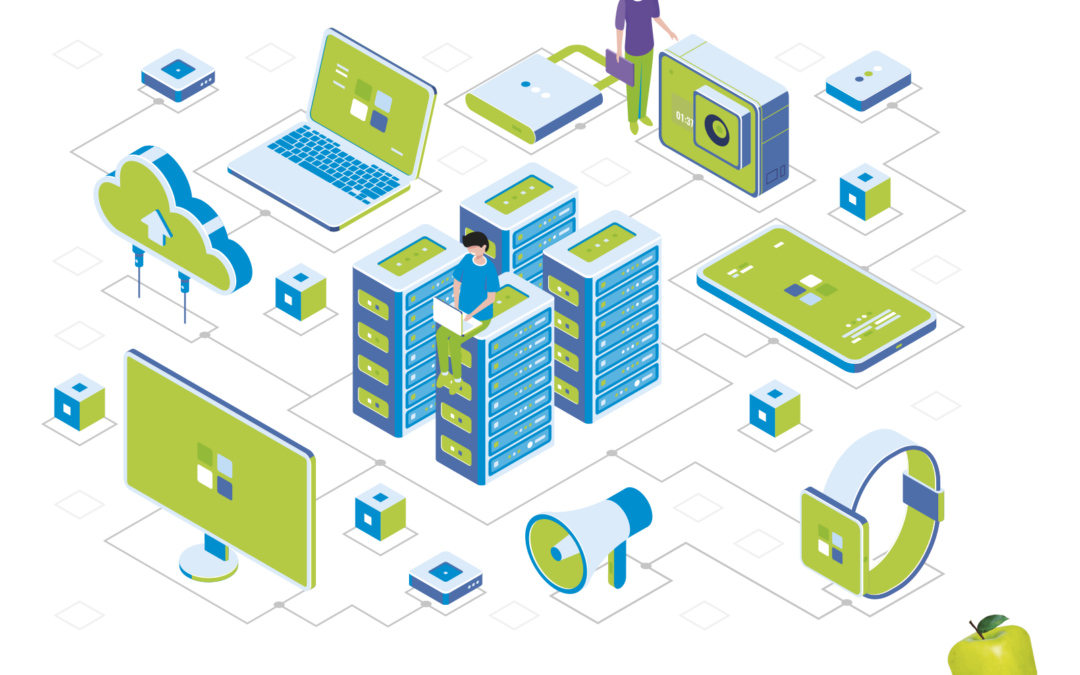
by Huenei IT Services | Jan 31, 2023 | Software development
Organizations today must develop technological solutions capable of responding quickly and efficiently to customer demands, and thus offer the best experiences. This new digital paradigm gave rise to the birth of software factories.
Software currently plays an important role in the development and evolution of companies. Software facilitates applications that support the operations and strategy of organizations. The importance of software for companies and society, in general, lies in the facilities it provides. This is related to optimizing tasks, increasing profits, reducing costs, minimizing time… In other words: making the company’s operations easier and, therefore, enhancing strategy and competitiveness.
Software development is carried out by technology-lovers, like us at Huenei. When these come together in a company dedicated to development, we are talking about a Software Factory.
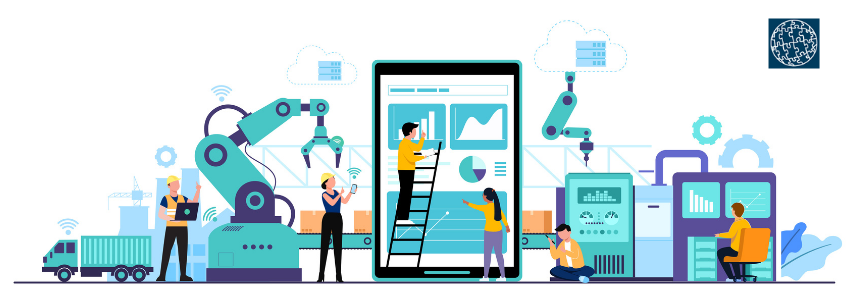
Illustration by Sicma21
What is a Software Factory?
A software factory is a company dedicated to developing software products for its clients, adapting the developments to their specific needs. While IT and technology consultants cover the entire creation and development cycle, software factories focus specifically on development.
Modern software factories adopt innovative approaches that facilitate collaborative development guided by the specific needs and requirements of customers and users. These organizations focus on understanding the key needs that the products to be developed must cover. Likewise, the work methodology is fast, based on rapid trial and error, and focused on continuous improvement.
Let’s dive into it! Some characteristics of software factories
Agile is the core principle of the whole operation. Being nimble and responsive should permeate the development process. This generally means collaborating in ways you never have before.
A basic but fundamental pillar is automation. This saves a lot of time in prototyping, development, testing, and refinement of products. All of this translates immediately into creating greater value for the customer.
You also need to consider security. Customers today demand high-security standards. Many times, software factories develop programs and applications that will handle sensitive data. This information can be key to the company’s operations and even to its strategy. This is why the security that your developed platform can provide truly makes a difference.
A software factory needs to be customer-centric to be successful nowadays. This means focusing on providing you with great experiences; This should be the number one business priority. Insights gleaned from ongoing customer feedback are the fuel that keeps the factory moving.
Digitization has become a fundamental axis in any company that offers its services. That is why if you want to acquire a competitive differential for your organization, you need to join the wave of digital transformation. Remember, taking advantage of these trends and being one of the first in your industry to transform digitally can bring you great opportunities in the future!
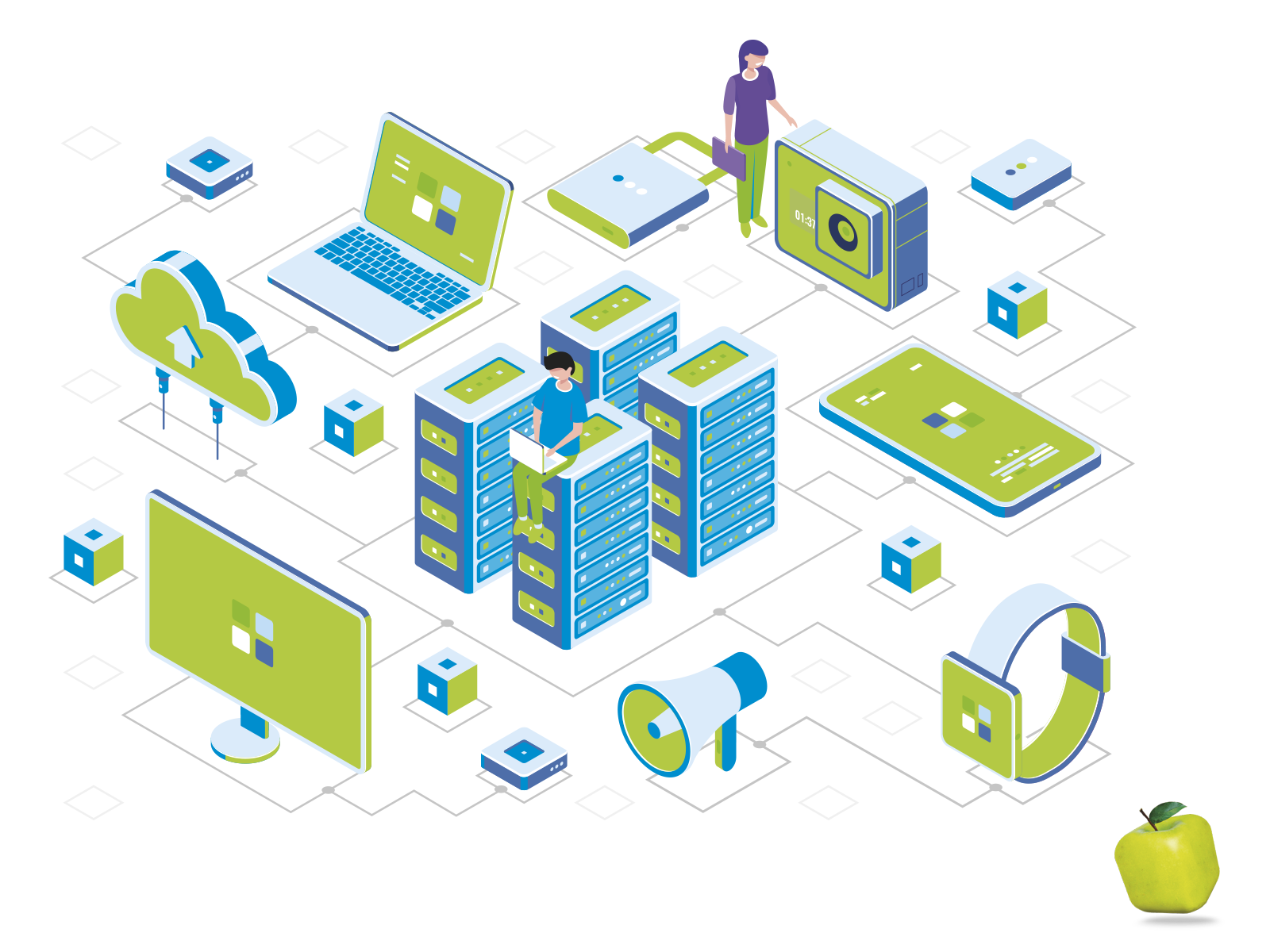
Illustration by Tecnova
What are the benefits of hiring a software factory?
- You have a team that guarantees all the profiles that your project requires. Regardless of the characteristics that your project needs, a Software Factory will always have trained and specialized personnel to carry out your project. The specialization of the technology teams is an important differential of these software development companies. At Huenei we have experts in development, prototyping, testing, UX/UI, and other specialties that your project may require.
- You don’t need to have 100% of the roadmap to start the project. You just need to have a first clear idea of the problem you need to solve and a software factory team can start working on potential solutions.
- Times and costs are defined from the beginning. The use of agile methodologies throughout the entire process speeds up times and minimizes costs. Thanks to the experience of software factories, professionals can accurately project budgets and development times.
- You will see incremental deliveries until the final product is complete. This is another of the virtues that agile methodologies present. It is not necessary to get the finished product for you to understand what the members of the software factory are working on. You will constantly be presented with advances, prototypes, and test units, as well as a minimum viable product so that you can visualize different incremental instances of development.
- Your product will be finished without having to dispose of the total operating time of the Technology area.
Digital transformation is what most companies are seeking to achieve, particularly in what we are now calling the fourth industrial revolution. Technology and software development companies are key to accompanying organizations like yours in all aspects of software production: from the initial stages of product specification to the maintenance of the product after it is in operation. In this sense, software factories play a fundamental role that can help your organization gain momentum and stand out from the competition.














